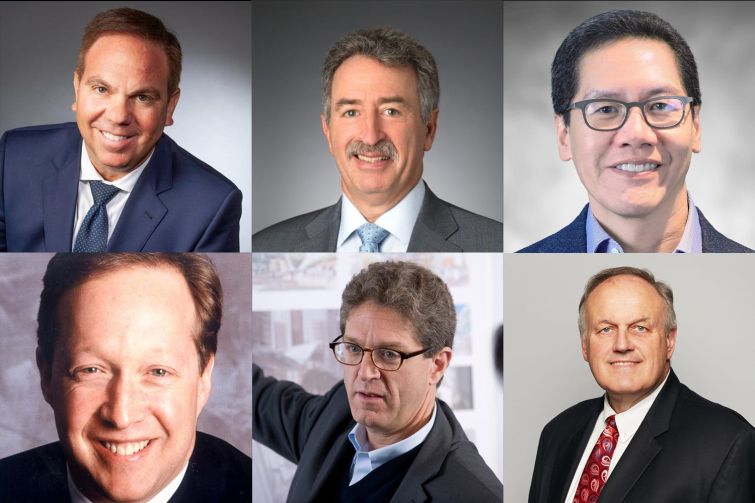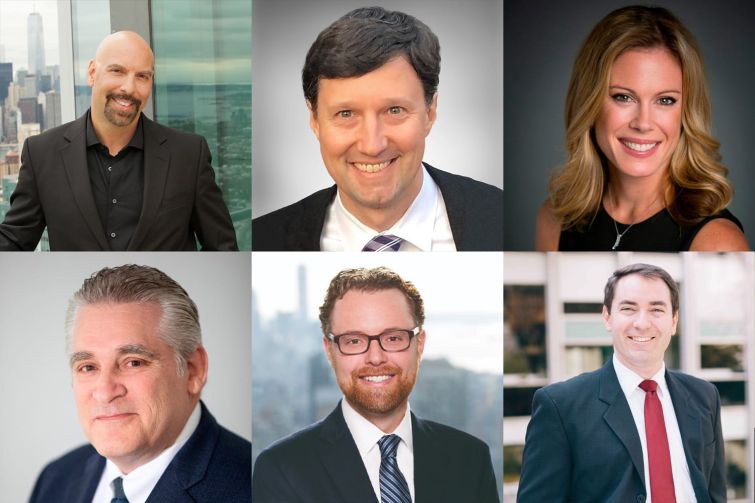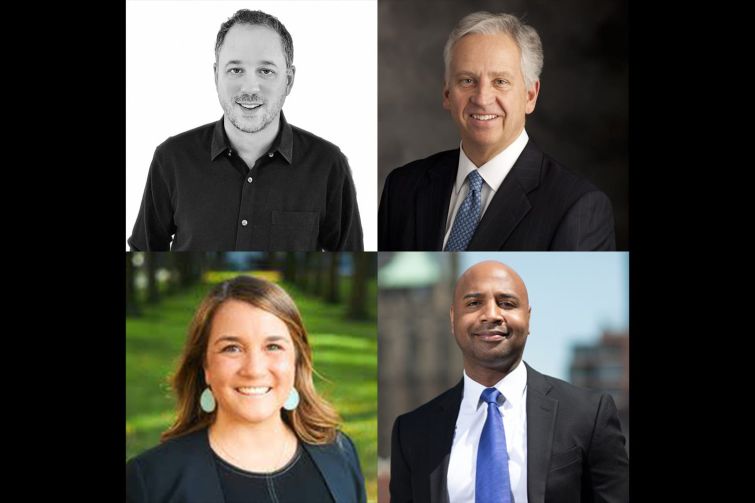Here’s How Landlords Can Make Tenants Feel Comfortable About Returning to the Office
Commercial Observer assembled a gaggle of experts as reopening plans intensify
By Rebecca Baird-Remba March 24, 2021 3:59 pm
reprints



Office building owners are still figuring out how to square immediate anxieties about returning to work with longer-term concerns about making their properties more energy efficient and flexible, landlords said during Commercial Observer’s “Making of a Modern Office” event on March 18.
“Fresh air is talked about more and more, but that runs counter to the public policy initiative of making more efficient buildings,” said Dean Shapiro, head of U.S. development at Oxford Properties, speaking on a panel moderated by Fried Frank’s Jonathan Mechanic.
Oxford is working on the redevelopment of the old St John’s Terminal building in Hudson Square into a 1.3 million-square-foot corporate office for Google (GOOGL). He noted that Oxford has put a number of pandemic-friendly measures into the building, including touchless entry options and ionized filtration systems in the elevator cabs. The building will also include 3 acres of terraces — on the third, fourth and 11th floors — and a bike room with space for 1,000 bikes. The project also involved putting in a new sidewalk and new public access points to Hudson River Park through the site.
“There’s a lot of science that needs to play out that we don’t know in terms of how the virus moves,” said Brendan Weiden, a partner at engineering firm Jaros, Baum & Bolles, who noted that there are questions about how well ionizers and UV lights work against airborne COVID-19 viruses. “Getting [HEPA] filters is a good and easy thing, and increased ventilation to make the virus less potent. Every building can do that now, today.”
He also sang the praises of a DOAS — dedicated outside air system — which helps distribute outside air to specific, occupied parts of a building.
Haniel Lynn, CEO of Kastle Building Systems, said that some of his clients are clamoring for real-time visualizations of air quality, which would allow tenants to make their own decisions about coming into work or entering certain spaces. A real-time look at air quality could also allow landlords or tenants to lock people out of certain spaces — such as gyms or conference rooms — if they get too crowded.
“We have monitors in our common spaces that show the air quality, but I think it’s kind of confusing because 1 is good and 100 is bad,” said Marx Realty CEO Craig Deitelzweig, explaining that his tenants don’t always know how to interpret the air quality data that he displays in his buildings.
Elevators remain a tricky question for architects and engineers, who know that significantly fewer people can fit in an elevator cab as long as the coronavirus is a concern. Developers, on the other hand, don’t want to build more elevator shafts unless it will be necessary for the long term.
“We are not seeing any less elevator density,” said James von Klemperer, president and a partner at architecture firm Kohn Pedersen Fox Associates. “We are packing as many people as we can for the future on those floors.” He pointed to the concepts of double-decker elevators — in which two cabs are fused together — and Thyssenkrupp’s Twin elevator system, where two elevators move independently of one another in one shaft. Both would allow more elevator capacity in a single shaft while allowing passengers to spread out somewhat.
On the second panel, landlords and engineers discussed how they’ve retrofit existing buildings to make tenants feel more comfortable about coming back to work, and what kind of building technologies are gaining importance during the pandemic.
Callie Haines, an executive vice president at Brookfield (BN) Properties, said that her firm has put in bipolar ionization and MERV-13 or higher filters across its buildings in order to effectively filter viruses out of the air. But the landlord is working on other pandemic-oriented programs, too.
“Brookfield has been really supportive about providing additional ways to commute to the office,” said Haines, who noted that the company is putting showers, changing rooms and bike rooms into many buildings. “So, if you do walk, run, bike, there are going to be places to regroup and change. We’ve been partnering with the corporate shuttle VIA for Brookfield employees to get $5 rides to the office.”
Todd Burner, chief product officer at Kastle Building Systems, noted that when people start returning to the office, “there will be a focus on air quality, and a lot of focus on mobility throughout the building. How do we use the phone to control elevators, open doors, see how many people are on that outdoor terrace, so I can decide whether I want to go up there? These are things that will be important during the pandemic period, but also have value in the long term.”
He added that many tenants and landlords had begun asking for a way to tie access to the building to COVID screening questions, which employees usually fill out daily before going to the office.
“People are saying, ‘We want to deactivate everyone’s credential every night and then we want them to make a reservation for the space, and then we want them to attest that they’re healthy. And only then do we want them to occupy the space,’” Burner said. “We can have a mobile experience that brings all that together.”
MG Engineering President Michael Gerazounis, the panel’s moderator, felt that some people may not love having to jump through hoops in order to come into the office. “I think we’re going to give up some liberties in regards to this kind of safety,” he said.
Meanwhile, David Neil, a principal at The Durst Organization, took the office landlord line on people coming back to work in person.
“The narrative is very puzzling to me about coming back to the office, not coming back to the office, working remotely forever,” he said. “People are asking, ‘Is it even valuable to come back?’ Of course it’s valuable to come back. We need to remind people, we need to communicate with the marketplace. We can’t give folks an excuse to not come back, so we need to give them confidence.”
Raphael Rosen, CEO of emissions reduction firm Carbon Lighthouse, explained that tenants will develop that confidence with the help of real-time data and sensors that tell them what’s happening in the building.
“The way to fight that darkness and fear is obviously with light and transparency,” Rosen said. “Tell people that if they come back to the building, they’re going to be tested. You’re going to have solutions that show people all the particulates, the CO2 levels, and give people the power to decide for themselves.”
Steve Levine, president of Atmos Air, an air purification firm, also spoke on the panel.
During the next panel, experts discussed what kind of health-related amenities are taking on more importance this year.
Matt McCambridge, CEO of boutique medical provider Eden Health, said that landlords should be focusing on how they can integrate into employees’ lives beyond building access.
“If you’re going to be competing with other buildings, how do you stay relevant for an individual even when they’re not in the office?” McCambridge said. “For those two days they’re not in the office, what are you providing for them. For example, we’re going to be having booster shots for the COVID vaccine on an ongoing basis, and probably integrate that with flu vaccines. You’re actually in an ideal position as a landlord to help facilitate that and make that simple.”
Thais Galli, a managing director at Tishman Speyer, reiterated the need for sensors that provide data about crowding and air quality in buildings. Landlords like Tishman Speyer need to “have the sensors, so you know how full the spaces are and you only go to spaces where you’re comfortable.”
Clinton Robinson of Lane and Jessica Brown of Sterling Bay also spoke on the panel, while Fred Berk of Friedman LLP moderated.
The final talk of the day focused on the state of coworking and flexible office spaces during the pandemic.
Hines executive Annie Rinker felt that coworking would eventually bounce back from its coronavirus-induced losses.
“Unfortunately, in our industry, we’ve had a lot of casualties because of COVID,” Rinker said. “I think we’re going to be seeing in the next 12 to 18 months, there’s going to be an undersupply issue because many operators have not made it to the other side of COVID. But I think COVID has taught us that the lease arbitrage model that the industry was built on does not work. And I think that that’s a strong lesson that both operators and landlords are understanding at this point.”
Jeremy Bernard, CEO of essensys’ North American branch, said that remote cybersecurity had taken on a new significance during the pandemic, as many workers would likely continue to work from home, coworking spaces, or satellite offices for the foreseeable future.
“How can you deliver that security when people are working from a local office one day, their home another day and HQ a third day?,” he said. “How are you able to flip open your laptop and be on a secure network from each of those different locations? That’s a complex problem that we have a solution for.”
Despite Rinker’s blunt assessment, Bryan Koop of Boston Properties said that he only had to take back one space from a coworking operator so far, in a building in Boston. Koop said that the landlord had tried to continue to operate flex spaces in its buildings, by providing movable walls and reliable Wi-Fi service everywhere.
Nadir Settles of Nuveen noted that tenants may want flex space as a way for tenants to spread out employees in different rooms and areas.
“Maybe the tenant wants flexible space, maybe the tenant wants a hoteling model, maybe the tenant wants breakout spaces,” Settles said. “We want to think about using flex space to accommodate what tenants want.”


